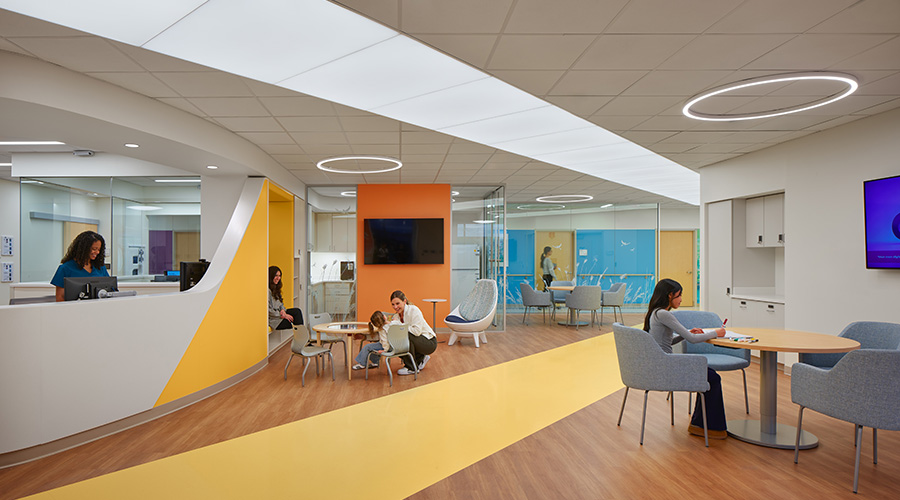The role of a hospital is rather simple to explain. Assist the patients in the healing process so they may return home and to their lives. Anything that assists in that mission is welcomed and anything that hinders should be eliminated. Study after study shows that excessive noise at hospitals hinders patients and negatively impacts the healing process.
There are a number of trends that are arising in the noise reduction industry which are helping hospitals help their patients.
In addition to helping patients heal, hospitals are also motivated to reduce noise levels as it impacts funding and is part of the building code. The HCAHPS (the Hospital Consumer Assessment of Healthcare Providers and Systems) is a determining factor in how much funding a hospital will receive from Medicare and Medicaid.
Inspiration to reduce noise is also motivated by FGI Facilities Guidelines Institute which creates building codes that states adopt (though each may have their own editions), and hospitals must adhere too. These codes also include points about acoustic requirements.
While the connection to healing and noise may be intuitive, acoustics also impact hospital staff. "If it is too noisy, it can be fatiguing, make it harder to think and perform required tasks and lead to staff burnout and lower employee satisfaction," said Ben Davenny, Principal Consultant for Acentech.
The company, which is an offshoot of Bolt Beranek and Newman (BBN), the founders of the acoustics consulting profession, has been around since the early 90's and does work throughout the US with a concentration in Boston, where it is located.
Davenny added two more reasons why acoustics is getting more attention. "Studies show hospitals are noisier than 20-30 years ago, and this is partly due to architecture and the equipment," he said. Attention to the noise issue drew greater attention around fifteen years ago when some studies were published and picked up by news outlets in the popular press.
Insuring acoustics are up to code and are at reasonable levels that will prove beneficial to patients and staff is easier to handle during construction. It's also less costly to make decisions during design process. Making changes when hospital is already functioning will disturb patients and staff.
In addition, it's more difficult and costly. Davenny and Acentech worked with Boston Medical Center who had two campuses and decided to consolidate to one which meant a renovation and addition to one of their campuses.
"The goal of the process was to try and make as many decisions early rather than later to minimize guess work and unpredictable things during construction."
Sound masking
One of the keys to the noise reduction industry in hospitals is sound masking, the production of a steady level of background sound from loud speaker systems. This is done to enhance privacy and reduce disruptions from startling intruding noises.
Many people term this white noise, but Davenny said this is not technically correct. "The goal is to create a steady combination of sounds of different frequencies designed to be unobtrusive yet cover up speech and other kinds of sounds."
Introducing sound masking into a hospital does increase costs. On the other hand, it reduces privacy complaints and boosts the patient experience. "Implementing good acoustical features early in design, including sound masking, reduces overall costs," said Davenny.
The tools used in sound masking, silencers/mufflers, need to be carefully considered as they have to be cleanable in order to control for infections.
Sounds masking is used a lot more in exam and consult rooms rather than in patient rooms. However, sound masking can help there since it can provide background sound to reduce startle noises from other sounds, making its way into patient environments.
Davenny noted that he and Acentech are in the midst of a project where sound masking is being inputted into patient rooms. "We are interested to see how it adopted and if it is liked and if it will become more standard in the future.
There are two types of sound masking systems: direct field and plenum based. Direct field means putting speakers pointed down in the ceiling tiles. Plenum based means putting larger loud speakers above the ceiling. Each type of system has its advantages and disadvantages.
Direct field is targeted towards smaller spaces and offers better control for these spaces. These systems are good at providing unobtrusive background sound and are much better than small individual systems. A drawback is that they require cutting holes in the ceiling tile which can introduce an element of visual clutter into the ceiling.
However, "Ceiling systems can be designed to accommodate the speakers and reduce clutter," said Davenny. "It's a design decision by the architect." When installing a plenum sound masking system, speakers can be spaced further apart since each speaker covers a larger area, and the speakers are not visible to building occupants.
A drawback, according to Davenny, is that they are harder to install after the fact if you wanted to add masking to an existing facility.
Trends beyond sound masking
Davenny noted there are other trends beyond sound masking that are occurring in hospitals to actually reduce noise. These trends include rubber flooring products as opposed to vinyl. "They can be quieter in terms of generating floor noise and overall noise in the environment and can satisfy clean-ability."
Various machines and technology are contributing to the increase in noise in hospitals. Acentech often reviews vibration of structures which is important in operating rooms and imaging facilities as equipment is highly sensitive to this. Excessive vibration can cause equipment to not function properly.
"People in this field are working to get the devices to talk to each other and measure and read different data," said Davenny. "The goal is to develop an interoperability between medical devices so they will be smarter about generating alarms."
The MRI is a particularly loud machine. Because of the noise they create, MRI's need lots of sound isolation as they transmit noise to other spaces. So, companies are developing quieter MRI scans. Another goal of the quieter MRI scans is to comfort the patients inside the MRI.
Concern over acoustics in hospitals is sure to remain and quite possibly grow. Davenny sees a trend of moving patients out of expensive downtown hospitals and into satellite offices or healing centers in the interest of costs. This will leave the hospital population sicker and in need of intense care. Hospital staff will be harder pressed to help patients heal. A quiet atmosphere can certainly help.

 Contaminants Under Foot: A Closer Look at Patient Room Floors
Contaminants Under Foot: A Closer Look at Patient Room Floors Power Outages Largely Driven by Extreme Weather Events
Power Outages Largely Driven by Extreme Weather Events Nemours Children's Health Opens New Moseley Foundation Institute Hospital
Nemours Children's Health Opens New Moseley Foundation Institute Hospital Code Compliance Isn't Enough for Healthcare Resilience
Code Compliance Isn't Enough for Healthcare Resilience Ribbon Cutting Marks First Phase Completion for New Montefiore Einstein Facility
Ribbon Cutting Marks First Phase Completion for New Montefiore Einstein Facility